![]()
![]()
![]()
Use LEFT and RIGHT arrow keys to navigate between flashcards;
Use UP and DOWN arrow keys to flip the card;
H to show hint;
A reads text to speech;
115 Cards in this Set
- Front
- Back
|
During the years following World War II the U.S. embarked on one of its greatest periods of ___________.
|
economic expansion
|
|
|
During the postwar years, the Gross National Product of the United States more than ________.
|
doubled
|
|
|
GNP
|
Gross National Product
|
|
|
The total amount of goods and services produced by a national economy.
|
GNP
|
|
|
From 1945 to 1960 the per capita income nearly ______________.
|
doubled
|
|
|
The average income per person.
|
per capita income
|
|
|
A giant corporation that invests in a wide range of businesses that produce different kinds of goods and services.
|
conglomerate
|
|
|
A corporation made up of three or more unrelated businesses.
|
conglomerate
|
|
|
Gives a group or individual the right to market a company's goods or services.
|
franchise
|
|
|
A business that contracts to offer certain goods and services from a larger parent company.
|
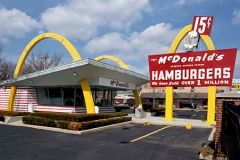
franchise
|
|
|
Many unique stores, with ties to the local community, were replaced as a result of the __________
|
franchise system
|
|
|
Two business systems or strategies that contributed to a major expansion of business in the 1950s.
|
conglomerates and franchises
|
|
|
In 1955, the average American family watched television _________.
|
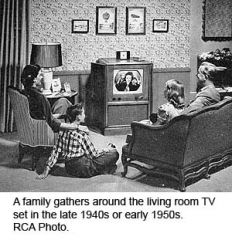
four to five hours a day
|
|
|
In the early days of television many programs were broadcast __________.
|
live
|
|
|
Advertisements on this new medium helped spur economic growth in the post war years.
|
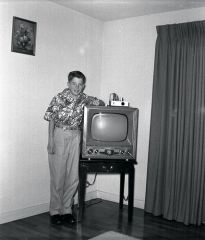
Television
|
|
|
A 1950s technological innovation furthered by research during World War II.
|
the computer
|
|
|
Computer use became much more widespread in the 1950s mainly because they became _____.
|
smaller and faster
|
|
|
Term introduced by Grace Hopper, when she removed a moth that had become caught in a relay switch that caused a large computer to shut down.
|
debugging
|
|
|
Ridding a computer of program errors.
|
debugging
|
|
|
A tiny circuit that improved the transmission of electronic signals.
|
transistor
|
|
|
A tiny circuit device that amplifies, controls, and generates electrical signals.
|
transistor
|
|
|
One of its major impacts was to reduce the size of electronic appliances.
|
transistor
|
|
|
Doctor who developed the vaccine against polio. (first successful field test 1954)
|
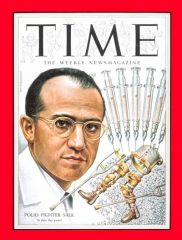
Jonas Salk
|
|
|
Penicillin and others were developed before World War II, but during the 1950s, doctors discovered more of these drugs including ones that were effective against penicillin-resistant bacteria.
|
antibiotics
|
|
|
Business expansion after World War II resulted in a shift in the work force from ____________.
|
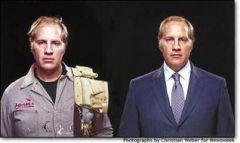
blue-collar to white collar jobs
|
|
|
By 1956 more Americans held _________ than __________ jobs.
|
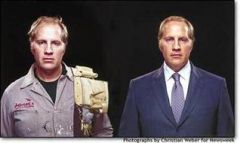
white-collar blue-collar
|
|
|
Some people believed that white-collar workers were less connected with products and services their companies provided and were more likely to ___________.
|
conform in their behavior
|
|
|
The high birth rate that started during World War II and continued after the war was over.
|

baby boom
|
|
|
It began in the mid 1940s, during World War II and peaked in 1957.
|
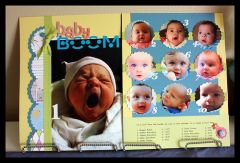
baby boom
|
|
|
One result of the baby boom was families moving from the _____________.
|
cities to the suburbs
|
|
|
It was passed by Congress in 1944 to give World War II veterans benefits like college tuition and low-interest mortgage loans.
|
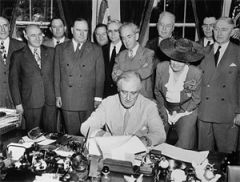
GI Bill of Rights
|
|
|
Servicemen's Readjustment Act of 1944.
|
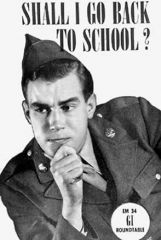
GI Bill of Rights (or GI Bill)
|
|
|
Law that provided fuel for the postwar economic boom and the modern middle class lifestyle that developed in during the 1950s.
|
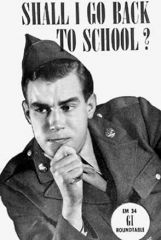
GI Bill of Rights
|
|
|
Developer who mass-produced new communities in the suburbs.
|
William J. Levitt
|
|
|
William J. Levitt contributed to the growth of suburbs by _____________________.
|
mass-producing houses
|
|
|
Name William Levitt gave to his new communities.
|
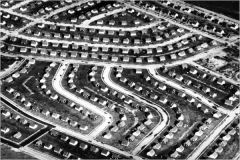
Levittown's
|
|
|
Following their customers many stores moved from the cities to _______.
|
shopping centers in the suburbs
|
|
|
Because many people moved beyond the reach of the public transportation systems they became more dependent upon _____.
|
cars
|
|
|
From 1948 to 1958, passenger car sales increased by more than __________.
|
50%
|
|
|
The increase in the number of cars created a need for better roads and resulted in the 1956 _______.
|
Interstate Highway Act
|
|
|
Provided $25 billion to build an interstate highway system more than 40,000 miles long.
|
Interstate Highway Act
|
|
|
Inspired the development of many new businesses, including: gas stations, repair shops, parts stores, drive in movies and restaurants.
|
the car culture
|
|
|
One long-lasting effect of the major highway-building projects of the 1950s was less reliance on the _________________.
|
public transportation system
|
|
|
Eager to cash in on the increasing number of cars on the roads gasoline companies began offering ___________.
|
credit cards
|
|
|
They became a popular means of purchasing things because of their ease and convenience.
|

credit cards
|
|
|
Just like installment plans in the 1920s, credit cards introduced in the 1950s encouraged consumers to purchase beyond their ____________.
|
means
|
|
|
After the years of depression and war, many Americans were searching for ____.
|
security
|
|
|
In the 1950s Americans placed the greatest value in ________.
|
comfort and security
|
|
|
Name given to the youth of the 1950s.
|
"silent generation"
|
|
|
In the 1950s they seemed to have little interest in the problems and crisis in the larger world.
|
"silent generation"
|
|
|
Members of the "Silent Generation" chose to pursue ________________.
|
entertainment and fun
|
|
|
The popularity of Billy Graham in the 1950s reflected a new interest in ___________.
|
religion
|
|
|
The renewed interest in religion in the 1950s was partially a response to the Cold War's struggle against ___________.
|

"godless communism"
|
|
|
In 1954 what words were added to the Pledge of Allegiance?
|
"under God"
|
|
|
In 1955 Congress required what phrase to appear on all American currency?
|
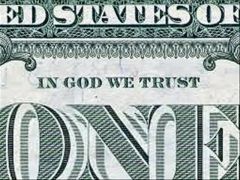
"In God We Trust"
|
|
|
Americans in the post-World War II years were keenly aware of the roles that they were expected to play as _____________.
|
men and women
|
|
|
Making important decisions, supporting their families financially, and going to school were all parts of _______________.
|
men's roles during the 1950s
|
|
|
During the 1950s most American women were expected to be ____________.
|
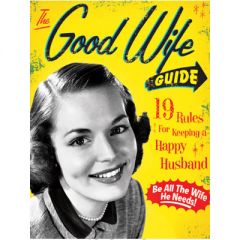
full-time homemakers
|
|
|
Were expected to manage the household by American society in the 1950s.
|
women
|
|
|
Pediatrician who wrote a highly influential book on child care.
|
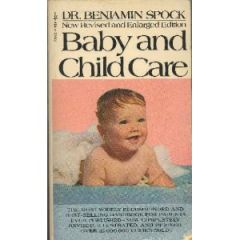
Benjamin Spock
|
|
|
Pediatrician and child care advisor who believed women should stay at home with their children.
|
Benjamin Spock
|
|
|
Critics of Dr. Spock's child care advice believed it was too __________.
|
permissive
|
|
|
In spite of the traditional roles that were expected many of THEM had enjoyed working outside the home during WWII and were reluctant to give up their good jobs.
|
women
|
|
|
More of them held paying jobs in the 1950s than ever before.
|
women
|
|
|
The number of married women working outside of the home rose from _____________.
|
24% in 1950 to 31% in 1960
|
|
|
Author of The Feminine Mystique.
|
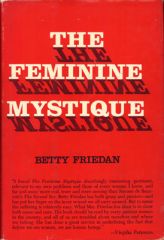
Betty Friedan
|
|
|
Woman's rights advocate who believed that the culture wrongfully forced women into staying at home and caring for children.
|
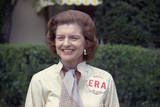
Betty Friedan
|
|
|
Films like "Rebel Without a Cause" and books like "The Catcher in the Rye," reflected the alienation of many of America's youth in the 1950s and their desire to resist the pressure to ______.
|
conform
|
|
|
Popular music combining elements of rhythm and blues, gospel music, and country and western music, and known for its strong beat and urgent lyrics.
|

rock 'n' roll
|
|
|
Gave young people in the 1950s a music style that they could call their own.
|
Rock 'n' roll
|
|
|
Disc jockey who first used the term rock 'n' roll to describe the new style of music emerging in the 1950s.
|
Alan Freed
|
|
|
Literary movement of the 1950s that rejected uniform middle-class culture and sought to overturn the sexual and social conservatism of the period.
|
beat movement
|
|
|
Counter-cultural group of the 1950s that promoted spontaneity over conformity.
|
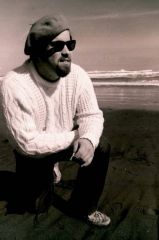
beatniks
|
|
|
Counter-cultural group of the 1950s that rebelled against conformity and traditional social patterns.
|
beatniks
|
|
|
Considered the spiritual leader of the Beat Generation.
|
Jack Kerouac
|
|
|
Author of "On the Road."
|
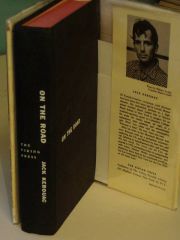
Jack Kerouac
|
|
|
Another name for the Beat Generation.
|
beatniks
|
|
|
The resurgence of religion and the rise of rock-and-roll were examples of _____________.
|
disparate trends in the 1950s
|
|
|
The social and economic transition to peacetime after war.
|
reconversion
|
|
|
When the government lifted price controls after the war, prices rose _____________.
|
faster than wages
|
|
|
One of the greatest challenges that President Truman faced in reconverting to a peacetime economy was keeping _______________.
|
inflation in check
|
|
|
Although Truman agreed that workers deserved higher wages, he thought their demands were ______________.
|
inflationary
|
|
|
When a railroad strike disrupted the economy in 1946, President Truman attempted to _____.
|
draft the striking workers into the army
|
|
|
This law was passed by Congress in 1947 to restrict labor strikes that threatened the national interest.
|
Taft-Hartley Act
|
|
|
The Taft-Hartley Act was a piece of anti _____________________.
|
labor legislation
|
|
|
The Taft-Hartley Act was passed over Truman's ____.
|
veto
|
|
|
Truman's plan which extended Roosevelt's New Deal goals.
|
The Fair Deal
|
|
|
A higher minimum wage, national health insurance, and housing assistance were all parts of Truman's ________.
|
Fair Deal goals
|
|
|
In the 1946 mid-term elections Republicans won majorities in both ___________.
|
houses of congress
|
|
|
Area where Truman found opposition throughout his presidency.
|
civil rights
|
|
|
Truman attempted to make progress in civil rights but was consistently blocked by __________.
|
congress
|
|
|
Progress in the area of civil rights was made difficult because of the coalition between Republicans and _______.
|
Southern Democrats
|
|
|
He banned discrimination in the hiring of federal employees and ordered the armed forces to end segregation and discrimination.
|
Harry Truman
|
|
|
It did not appear that Harry Truman had much chance to win reelection in 1948 because he had lost support in his ____________.
|
own party
|
|
|
Southern segregationists split off from the Democratic party in 1948 forming the States' Rights or __________.
|
Dixiecrat Party
|
|
|
Dixiecrat Party nominee for the presidency in 1948.
|
Strom Thurmond
|
|
|
Truman also lost the support of the liberal wing of the Democratic party which supported Henry Wallace on the ticket of the ______.
|
Progressive Party
|
|
|
Truman's Republican opponent in 1948.
|
Thomas Dewey
|
|
|
Even though Truman won the election of 1948 and the Democrats won control of congress Truman had only occasional successes implementing his _____.
|
Fair Deal goals
|
|
|
Adopted in 1951, it limited the President to two terms in office.
|
Twenty-second Amendment
|
|
|
Democratic Candidate for President in 1952 & 1956.
|
Adlai Stevenson
|
|
|
President who was the former commander-in-chief of the Allied forces.
|
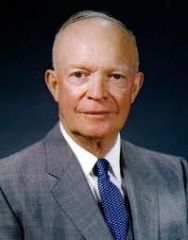
Dwight Eisenhower
|
|
|
Eisenhower's vice presidential running mate.
|
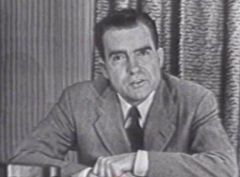
Richard Nixon
|
|
|
His formula for victory in the Presidential election of 1952 focused on: Korea, communism, and corruption.
|
Dwight Eisenhower
|
|
|
President Eisenhower's conservative approach to government.
|
Modern Republicanism
|
|
|
"dynamic conservatism"
|
Modern Republicanism
|
|
|
Cutting spending, reducing taxes, and balancing the budget.
|
Modern Republicanism
|
|
|
Eisenhower said he intended to be "conservative when it comes to money, and liberal when it comes to ___________."
|
human beings
|
|
|
Eisenhower endorsed a military strategy of relying on nuclear weapons, rather than more costly ______________.
|
conventional armies
|
|
|
Eisenhower and his administration supported _____.
|
big business
|
|
|
Because he favored big business President Eisenhower's domestic policy reflected his Republican predecessors _____________.
|
Coolidge & Hoover
|
|
|
The 1957 event that caused Congress to increase spending on teaching science and mathematics.
|
launching of Sputnik
|
|
|
Was an act designed to improve science and mathematics in schools.
|
National Defense Education Act
|
|
|
In response to Sputnik the U.S. government created an independent agency for space exploration ____.
|
NASA
|
|
|
NASA
|
National Aeronautics and Space Administration
|

